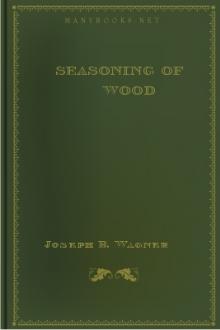Seasoning of Wood by Joseph Bernard Wagner (bill gates best books txt) 📕

Keeping especially in mind the arrangement and direction of the fibres of wood, it is clear at once why knots and "cross-grain" interfere with the strength of timber. It is due to the structural peculiarities that "honeycombing" occurs in rapid seasoning, that checks or cracks extend radially and follow pith rays, that tangent or "bastard" cut stock shrinks and warps more than that which is quarter-sawn. These same pecu
Read free book «Seasoning of Wood by Joseph Bernard Wagner (bill gates best books txt) 📕» - read online or download for free at americanlibrarybooks.com
- Author: Joseph Bernard Wagner
- Performer: -
Read book online «Seasoning of Wood by Joseph Bernard Wagner (bill gates best books txt) 📕». Author - Joseph Bernard Wagner
The Project Gutenberg EBook of Seasoning of Wood, by Joseph B. Wagner
This eBook is for the use of anyone anywhere at no cost and with
almost no restrictions whatsoever. You may copy it, give it away or
re-use it under the terms of the Project Gutenberg License included
with this eBook or online at www.gutenberg.net
Title: Seasoning of Wood
Author: Joseph B. Wagner
Release Date: September 12, 2008 [EBook #26598]
Language: English
*** START OF THIS PROJECT GUTENBERG EBOOK SEASONING OF WOOD ***
Produced by Jason Isbell, Irma Spehar and the Online
Distributed Proofreading Team at http://www.pgdp.net
A TREATISE ON THE NATURAL AND ARTIFICIAL PROCESSES EMPLOYED IN THE PREPARATION OF LUMBER FOR MANUFACTURE, WITH DETAILED EXPLANATIONS OF ITS USES, CHARACTERISTICS AND PROPERTIES
ILLUSTRATIONS
BY
JOSEPH B. WAGNER
AUTHOR OF "COOPERAGE"
NEW YORK
D. VAN NOSTRAND COMPANY
25 PARK PLACE
1917
COPYRIGHT, 1917, BY
D. VAN NOSTRAND COMPANY
THE·PLIMPTON·PRESS
NORWOOD·MASS·U·S·A
The seasoning and kiln-drying of wood is such an important process in the manufacture of woods that a need for fuller information regarding it, based upon scientific study of the behavior of various species at different mechanical temperatures, and under different drying processes is keenly felt. Everyone connected with the woodworking industry, or its use in manufactured products, is well aware of the difficulties encountered in properly seasoning or removing the moisture content without injury to the timber, and of its susceptibility to atmospheric conditions after it has been thoroughly seasoned. There is perhaps no material or substance that gives up its moisture with more resistance than wood does. It vigorously defies the efforts of human ingenuity to take away from it, without injury or destruction, that with which nature has so generously supplied it.
In the past but little has been known of this matter further than the fact that wood contained moisture which had to be removed before the wood could be made use of for commercial purposes. Within recent years, however, considerable interest has been awakened among wood-users in the operation of kiln-drying. The losses occasioned in air-drying and improper kiln-drying, and the necessity for getting the material dry as quickly as possible after it has come from the saw, in order to prepare it for manufacturing purposes, are bringing about a realization of the importance of a technical knowledge of the subject.
Since this particular subject has never before been represented by any technical work, and appears to have been neglected, it is hoped that the trade will appreciate the endeavor in bringing this book before them, as well as the difficulties encountered in compiling it, as it is the first of its kind in existence. The author trusts that his efforts will present some information that may be applied with advantage, or serve at least as a matter of consideration or investigation.
In every case the aim has been to give the facts, and wherever a machine or appliance has been illustrated or commented upon, or the name of the maker has been mentioned, it has not been with the intention either of recommending or disparaging his or their work, but has been made use of merely to illustrate the text.
The preparation of the following pages has been a work of pleasure to the author. If they prove beneficial and of service to his fellow-workmen he will have been amply repaid.
THE AUTHOR.
September, 1917
CONTENTS Section I TIMBER PAGES Characteristics and Properties of Same—Structure of Wood—Properties of Wood—Classes of Trees 1-7 Section II CONIFEROUS TREES Wood of Coniferous Trees—Bark and Pith—Sapwood and Heartwood—The Annual or Yearly Ring—Spring- and Summer-Wood—Anatomical Structure—List of Important Coniferous Trees 8-30 Section III BROAD-LEAVED TREES Wood of Broad-leaved Trees—Minute Structure—List of Most Important Broad-leaved Trees—Red Gum—Range of Red Gum—Form of Red Gum—Tolerance of Red Gum—Its Demands upon Soil and Moisture—Reproduction of Red Gum—Second-growth Red Gum—Tupelo Gum—Uses of Tupelo Gum—Range of Tupelo Gum 31-85 Section IV GRAIN, COLOR, ODOR, WEIGHT, AND FIGURE IN WOOD Different Grains of Wood—Color and Odor of Wood—Weight of Wood—Weight of Kiln-dried Wood of Different Species—Figure in Wood 86-97 Section V ENEMIES OF WOOD General Remarks—Ambrosia or Timber Beetles—Round-headed Borers—Flat-headed Borers—Timber Worms—Powder Post Borers—Conditions Favorable for Insect Injury—Crude Products—Round Timber with Bark on—How to Prevent Injury—Saplings—Stave, Heading, and Shingle Bolts—Unseasoned Products in the Rough—Seasoned Products in the Rough—Dry Cooperage Stock and Wooden Truss Hoops—Staves and Heads of Barrels Containing Alcoholic Liquids 98-113




Comments (0)